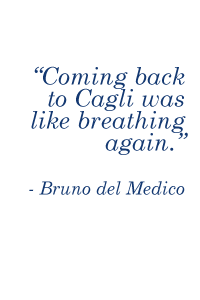Bruno del Medico: Holding the Gift
by Marty Lane
A long, stiff bamboo broom, a slender knife with a red plastic handle, and a blue dust pan are the simple tools Bruno del Medico uses to groom the walls lining the Via Flaminia around Cagli, Italy. He regularly removes tenacious plant sprouts from the walls to maintain their beauty and prevent deeper fractures. The speeding cars and trucks are no small threat as Bruno works in the narrow margins of the road.
Bruno’s job is a quid-pro-quo arrangement with the city of Cagli for his living space—a small room on Via Lapis. His colorful journey includes adventures both delightful and devastating, embracing his love of drawing and painting and the town of Cagli.
Sitting at the caffé with several of his art pieces stacked near his feet, Bruno points to one of the drawings—a female nude with her back to the viewer. The piece is rendered in charcoal on a soft pink paper. He explains the challenge of producing realistic drawings and asserts that “art is painstaking, and my work is so real that you might think you could eat a piece of fruit from a still life I paint.” The difficulty of the process is exacerbated by limits on his time; creating requires focus and making a living encroaches on creative space in his day. Bruno says the nude is one of 15 pieces remaining after an art dealer took his body of work to sell and was not seen again. Bruno’s discouragement over this loss diminished his drive to keep making art. In fact, he says, he refuses to do so.
In the evenings, Bruno descends the steep cobblestone street stretching from the cathedral to Via Flaminia—his tools in tow. With his knife, he slices the fledgling shoots emerging from the wall’s crevices. The clippings land among the rocks, empty bottles, and crumpled papers. With wide, strong strokes, he aims the sturdy broom at the debris, frequently working within the driving lane, dodging the fast-moving traffic. He moves the growing pile to the end of the wall; the air fills with fine dust. Using the dustpan as a scoop, he transfers the pile into a large plastic bag, moves down the street and repeats the process.
These streets are familiar to Bruno; he says he first came to Cagli in 1972 at 14. He began life in the southern town of Forga. When he was three, his mother died, and for the next 11 years he lived in a government orphanage. He says of his passion for art, “I was born with a pencil in my hand.” Wanting to develop his drawing and painting skills, he came to Cagli and enrolled in the Istituto Statale d’Arte. After two months, he left, he says, discouraged by the school’s emphasis on sculpture.
At 18, he says, when government assistance ceased, he left Cagli and moved to Rome. There, he painted portraits as a street vendor; he moved on to Genoa and managed a hotel, partnering with a woman from Algeria. The two had a daughter, Monica. Bruno says he woke one day to find his partner gone; she took all his money and left the child in his care. Penniless, Bruno returned to Cagli to raise Monica. “Coming back to Cagli”, he says, “was like breathing again—especially with the little girl—it was a respite.”
Some mornings Bruno arrives at the piazza carrying an empty wicker basket; it’s a day to pick mushrooms. “Sometimes I get 30 Euros a pound for good mushrooms, but lately it’s been too hot and too dry.” Later in the day he sits at Caffé Commercio, smoking a cigar and drinking an espresso with a basket half full of the delicate funghi. If he finds a buyer, he will sell them fresh; the rest he will freeze.
Reflecting on his life and his place in the community of Cagli, Bruno calls himself “an outsider…most people don’t understand me; I speak my mind.” He stresses – somewhat bitterly -- that the work he does to sustain his life is “not my work…not my work!” While the boy Bruno was born with a pencil in his hand, the man Bruno holds the gift inside after so many things got in his way.
Adventure with Us!








